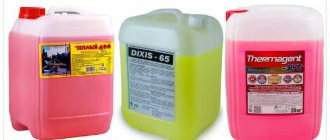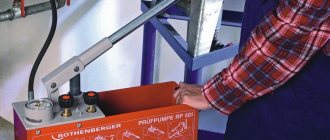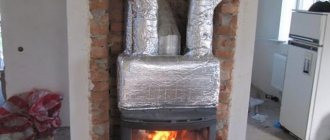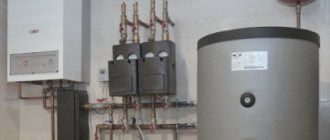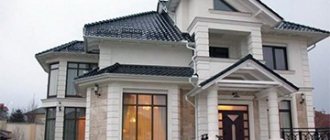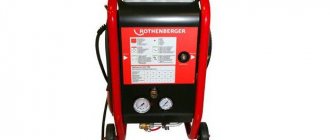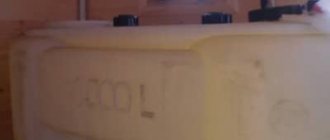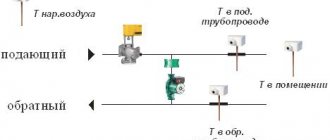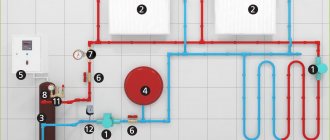The principle of operation of antifreeze
Water at 0°C abruptly and abruptly turns into ice, expanding by 11%. The pipes cannot withstand such a load. The heating system has to be dismantled, including the boiler and all radiators. Water is a good solvent, so even a small amount of antifreeze greatly shifts the crystallization point of water, and abrupt transformation into ice does not occur.
At subzero temperatures, water with the addition of antifreeze slowly thickens, and the liquid expands slightly, so the heating system remains safe and sound.
For example, the crystallization of water with 30% antifreeze liquid (propylene glycol) is so slow that there is no need to dilute the coolant to -30°C; it is enough to add antifreeze to the design temperature of -12-15°C. As the temperature drops below the calculated value, such a mixture will slowly but surely harden, and only at -30°C can it freeze completely.
Antifreeze service life
However, even a properly prepared composition has its own service life. Over time, the anti-freeze properties are lost.
- For glycol-based formulations, this time ranges from 4 to 5 years. After which they need to be replaced with fresh antifreeze, after flushing the system.
- For glycerin compositions, the declared period of use is 8 years.
softness and low oxygen content.
To reduce the likelihood of air locks, experts recommend using special bleed valves or Mayevsky taps on all radiators. These are additional costs, but they are necessary for the normal operation of the heating system, not only when using antifreeze, but especially when using water coolant.
Speaking about the preliminary preparation of water, it should be noted that in the case of using an electrode heating boiler, the water must have a certain electrical conductivity, i.e. have a certain degree of mineralization.
What is the difference between green and red antifreeze?
Pure 100% antifreeze is not used as a coolant - it is always diluted: from 20 to 35% antifreeze and 80-65% water, respectively. Only 2 types of antifreeze based on dihydric alcohols are used in heating: ethylene glycol and propylene glycol. Manufacturers produce both a concentrated composition and an already diluted one for pouring into the heating system. Ethylene glycol is a concentrated red solution, and ethylene glycol is a green solution. I will describe their differences below.
Ethylene glycol in the heating system
Raspberry colored solution. A toxic substance used in the automotive industry, the production of motor oils, plastic and cellophane. It has an extremely low pour point of -70°C. It is used primarily in heating and anti-icing systems of industrial facilities and football fields. It is not recommended to use ethylene glycol in heating systems of country houses due to its toxicity.
Rating of the best coolants on the domestic market
WARM ECO HOUSE
Propylene glycol substance. The manufacturer recommends using it in dual-circuit heating systems. During operation, it significantly loses its anti-corrosion properties. Not suitable for electrolytic boilers.
ADVANTAGES:
- Fire and explosion proof
- Provides reliable protection of heating and air conditioning systems from defrosting, scale and corrosion
- Additives based on mineral salts do not contain harmful nitrites, amines and phosphates
- Do not have an aggressive effect on metals, plastic, metal-plastic, rubber, paranit and flax
FLAWS
- Not detected
WARM ECO HOUSE
DIXIS-65
They are used both in industrial systems and for heating small private houses. Feature - freezing temperature - 65 degrees. When used in a region with mild winters, the substance can be diluted with water, which will reduce its cost. It has gentle properties on heating system materials and extremely low flammability.
ADVANTAGES:
- High frost resistance
- Heat exchange devices are not destroyed when frozen
- Maintains the heating system in ideal condition in the temperature range -65°C ... +95°C
- Can be used by diluting with regular tap water
- Prevents scale formation
FLAWS
- Not detected
DIXIS-65
Warme ECO 30
Harmless glycerin antifreeze, which has a neutral effect on humans and the environment. Diluted with a complex of additives to reduce the aggressive effect on the components of the heating system. Thanks to this, the metal and sealing elements do not damage. Contains a phosphor dye.
ADVANTAGES:
- Environmentally friendly product
- Incombustible
- Non-toxic
- Explosion-proof
- Contains a special complex of anti-corrosion additives
FLAWS
- Not detected
Warme ECO 30
TermoTactic EcoGreen – 30°
It has a glycerin base with added additives. Produced on the basis of European production. It is environmentally friendly and therefore recommended for residential buildings.
ADVANTAGES:
- Highly hygroscopic
- Easily mixes with distilled water in any proportions
- Non-toxic, ensures the safety of the environment and human life during operation and disposal
- The presence of a functional additive “corrosion inhibitor” - prevents the occurrence of physiological and physico-chemical processes when interacting with metals, plastics, rubber and paranitic seals
- Retains unchanged its original state when heated and cooled
FLAWS
- Not detected
TermoTactic EcoGreen – 30°
PRIMOCLIMA ANTIFROST – 30
Does not swell when frozen. There are no toxic components in the composition. Can be used for up to 8 years without replacement. The additives in its composition allow you to extend the life of heating system components.
ADVANTAGES:
- Effective package of anti-corrosion additives
- Inertness to sealing and gasket materials
- Long service life - up to 8 heating seasons
- Cost-effective - with a system volume of 100 liters, 115 kg of coolant will be required, and the product is completely ready for use
- Compatible with most antifreezes on a similar basis
FLAWS
- Not detected
PRIMOCLIMA ANTIFROST – 30
Aquatrust – 30
Propylene glycol antifreeze with extended service life. It is characterized by high cost. Used in enterprises, including public catering. Has antibacterial components.
ADVANTAGES:
- Latest anti-corrosion formula
- Extended life of corrosion inhibitors and antibacterial additives
- Improved heat transfer properties
- Service life is 3 times longer than traditional coolants
FLAWS
- Not detected
Aquatrust – 30
Propylene glycol in the heating system
Green solution, food additive E1520, used in the cosmetics industry. Pour point -50°C. 3 times more viscous and 2 times more expensive than ethylene glycol. It is used in buildings where there is a risk of the system defrosting, but compliance with environmental characteristics is required. We use propylene glycol in recuperators of restaurant ventilation systems. In our country, propylene glycol for the heating system is produced from imported raw materials, and therefore is much more expensive than ethylene glycol.
Which coolant should I choose for heating?
For a heating system, the differences between ethylene glycol and propylene glycol are insignificant, but different freezing temperatures (-70 and -50 ° C) affect the percentage of the substance. To ensure the same crystallization temperature (-25°C), almost 2 times less ethylene glycol is required than propylene glycol, but the relationship is not linear.
For example, when the concentration of ethylene glycol in water becomes more than 50%, its characteristics begin to decline. This is due to the ineffective operation of anti-corrosion additives, which do not come into contact with water well.
Which antifreeze is best for heating a home?
The main criterion for choosing antifreeze is safety!
Propylene glycol is used in the food industry. The substance is not toxic. It is used as antifreeze in heating systems of cottages, country houses and premises with constant occupancy.
If the building does not require environmental safety, for example, warehouses, garages and production workshops, you can safely use ethylene glycol. In all other cases - propylene glycol.
Glycerin in the heating system
I received a lot of questions about “glycerin”. Glycerin-based coolant in the heating system is unacceptable even in a diluted state.
Firstly, monstrous kinematic viscosity at negative temperatures (at 0°C -9000 m2/s x 106 - glycerin, 67 m2/s x 106 - ethylene glycol) - and therefore monstrous pressure losses. It will be difficult to push glycerin-based coolant through the pipes.
Secondly, the adhesion of organic glycerin particles to the surface of the boiler heat exchanger, its overheating and complete failure. Diluting glycerin with alcohols only leads to the formation of explosive compounds.
Any other non-freezing liquids, for example, antifreeze in the heating system, are unacceptable, because do not contain the required amount of anti-corrosion additives. The cost of antifreeze for heating is determined by the quality of these same additives, thanks to which some antifreezes last 5 years and others 10. Over the years, the antifreeze in the heating system oxidizes to form acetic acid, which leads to the destruction of brass connections on radiators, so it is important to change the coolant on time.
How to fill the heating system with antifreeze?
If we talk about the process of filling the heating system with antifreeze, it can be divided into three stages:
- system preparation;
- diluting the concentrate in the required proportion;
- direct filling.
The first stage is preparation
First, you need to inspect the heating system in your home and make sure that the connections are tight. If this is necessary, you can replace gaskets and materials that are incompatible with the active substance of the antifreeze. After this, it is necessary to check the heating system for leaks, scale and lime deposits on the pipeline and radiators. Next, you should calculate the required volume of coolant. This is quite easy to do. It is necessary to fill the heating system with water, and then drain and measure the amount of liquid using a measuring container.
The second stage is dilution of the concentrate
On sale today you can find many antifreeze solutions that are suitable for use in heating systems for private homes. They are ready for use and there is no need to dilute them. If you know the concentration and required volume of antifreeze well, then all you have to do is prepare distilled or ordinary water in the required quantity.
Next, you should prepare the container. It is best to use a barrel made of stainless steel or food-grade plastic. Water is poured into it in the required amount, and after that the concentrate is poured. An important point is that they should not be mixed to prevent the formation of foam saturated with oxygen. When the composition is prepared, a pump should be lowered into the barrel in which it is located for subsequent pumping of the non-freezing liquid. You need to connect a hose to the pump that connects to the drain valve. The second hose is removed and lowered into the barrel. It must be connected to the expansion tank drain. When performing the manipulation, you should not forget to open the tap on the bypass line of the circulation pump.
The third stage is filling the system
The pumping equipment is started, after which the heating system is filled until the non-freezing liquid comes out of the drain. Next, you should bleed the air using Mayevsky taps. If the heating system used in the house is of a closed type, then the same operations must be performed with the exception of connecting the expansion tank hoses.
You should be guided by the pressure in the system (1 - 1.5 kg/cm2) and by the appearance of antifreeze from the air vent. Next, you need to turn on the circulation pump and circulate the coolant through the circuit. The heating boiler must be turned off when performing this manipulation. After the pressure begins to drop, it is necessary to continue pumping “anti-freeze” into the heating system. Turning on the pump should be repeated until the pressure drop stops.
Heating with antifreeze or water
After reading this section, you will most likely refuse antifreeze in your heating system. The main advantage of antifreeze - the safety of the system at subzero temperatures - is completely negated by its disadvantages.
- Low heat capacity of antifreeze. Increasing the size of radiators by 20-23%
The heat capacity of antifreeze is significantly lower than the heat capacity of water. By diluting water with 35% antifreeze, we lose approximately 200 W per 1 kW of thermal energy. This means that the size of pipes, radiators and boiler must be increased by 20%. In terms of a country house of 300 m2, we lose approximately 60 thousand rubles by increasing the size of the system. Antifreeze is not applicable at all for underfloor heating systems, again due to low heat capacity.
- The service life of antifreeze is from 5 to 10 years. Over the years, antifreeze oxidizes and successfully destroys brass connections. After 5 - 10 years, ethylene glycol and propylene glycol must be drained, disposed of and replaced with a new one. You will not only have to buy new antifreeze, but also pay to dispose of the old one. Unfortunately, in our country there is no service for recycling ethylene glycol in small volumes, so finding someone to hand over this chemical to will be difficult. I won’t consider the idea of dumping antifreeze on my neighbor’s property.
- The use of sectional radiators in systems with antifreeze is unacceptable. Rubber sectional gaskets quickly oxidize, and the radiators leak. We use only steel panels. The use of galvanized pipes is also unacceptable. Antifreeze safely washes away the zinc, and the pipe remains bare.
- Why is antifreeze useless for a country house? Antifreeze will successfully cope with the task - the heating system will not freeze in winter in your absence, but what to do with the water supply system? At subzero temperatures, water supply pipes will freeze faster and with worse consequences, because... laid not only in the floor, but also in the walls. You will have to remove the tiles, beat the screed and change the pipes in the bathrooms, showers, kitchen, and also replace the entire water supply system of the boiler room. Of course, pumping antifreeze into the water supply system will not work, nor will laying all the pipes with a heating cable.
Conclusion: Antifreezes are suitable either for heating small country houses for temporary residence, or large warehouses, workshops and enterprises.
In the heating system of a full-fledged country house, antifreeze is useless.
Anti-freeze for the heating system of a private house
Anti-freeze for the heating system of a private house DIXIS-65 with ethylene glycol
This is a concentrated aqueous antifreeze based on monoethylene glycol. The manufacturer did not forget to add unique additives with which the antifreeze acquired heat-stabilizing, anti-foam, antioxidant properties and the ability to protect the system from corrosion.
In addition, the inertness of the liquid to sealing materials has increased significantly. The composition is completely ready for use and does not require dilution with water. However, the manufacturer allows two uses: without dilution and in diluted form.
Among the obvious advantages of anti-freeze over competitors, I would like to note its long service life - the liquid can work for up to 10 years (!). The product is characterized by high frost resistance and works to remove deposits on the internal surfaces of pipes. Antifreeze does not cause degradation of paronite, rubber, or Teflon seals.
The operating temperature range of the non-freezing liquid is simply amazing - from -65 to +95 degrees. Crystallization will begin at -66 degrees, boiling - from 111 degrees. Volume – canister 20 l. This anti-freeze for the heating system of a private house has a price of 1.8 thousand rubles.
Pros:
- fireproof;
- effective additive complex;
- wide range of operating temperatures;
- long service life – 10 years.
There are no cons.
Antifreeze liquid for the DIXIS TOP system on propylene glycol
This is a safe antifreeze based on propylene glycol, which distinguishes it favorably from traditional analogues based on ethylene glycol in terms of toxicological properties. The composition is intended for use as a working fluid in heat exchange systems of industry and residential buildings. It successfully eliminates “defrosting” when exposed to negative temperatures.
A complex of additives protects equipment from the development of microorganisms and the formation of corrosion. The liquid is compatible with metal-plastic, plastic pipes and seals, works in double-circuit boilers, in open systems, and allows commissioning at subzero temperatures. Crystallization begins at -31 degrees, freezing - at -40 degrees.
Due to the fact that antifreeze is prepared on the basis of food-grade propylene glycol, it can be safely used even in food industry systems, not to mention residential buildings. The drug provides excellent frost resistance and prevents the destruction of elements of heat exchange systems during freezing, corrosion of cast iron, steel, brass, aluminum and solder. Plus, it prevents the accumulation of scale and, in principle, prevents its formation. Volume – 20 kg canister. Price – from 1.9 tr.
Pros:
- eliminates system destruction;
- fireproof;
- favorable price;
- 100% output quality control;
- full set of additives.
Minuses:
not suitable for harsh Yakut winters.
Antifreeze liquid for the home heating system Antifreeze Thermotrust
Thermotrust antifreeze is used in the form of aqueous solutions or in its original form. It can be safely used in autonomous heating systems of residential buildings to prevent defrosting at low temperatures. The additive package is optimally balanced and provides protection against microorganisms, corrosion, and scale.
The composition is inert to sealing materials, contains heat-stabilizing, antioxidant, anti-foam components. Does not destroy cast iron, steel, copper, aluminum, brass and solder, compatible with metal-plastic and plastic pipes.
The basis of the liquid is monoethylene glycol, it is homogeneous, red in color, and does not contain mechanical impurities. In areas with a temperate climate it can be diluted with water; in the Far North it is used in its pure form. Crystallization temperature -66 degrees, boiling point 111 degrees. The price of a 20 l canister is from 1.8 tr.
Pros:
- high frost resistance;
- blocks degradation of elements of heat exchange systems during freezing;
- operates in the range -65 – +90 degrees;
- diluted with plain tap water;
- made from high-quality raw materials;
- service life is 5 years.
Minuses:
does not work with galvanized systems and electrode-type boilers.
